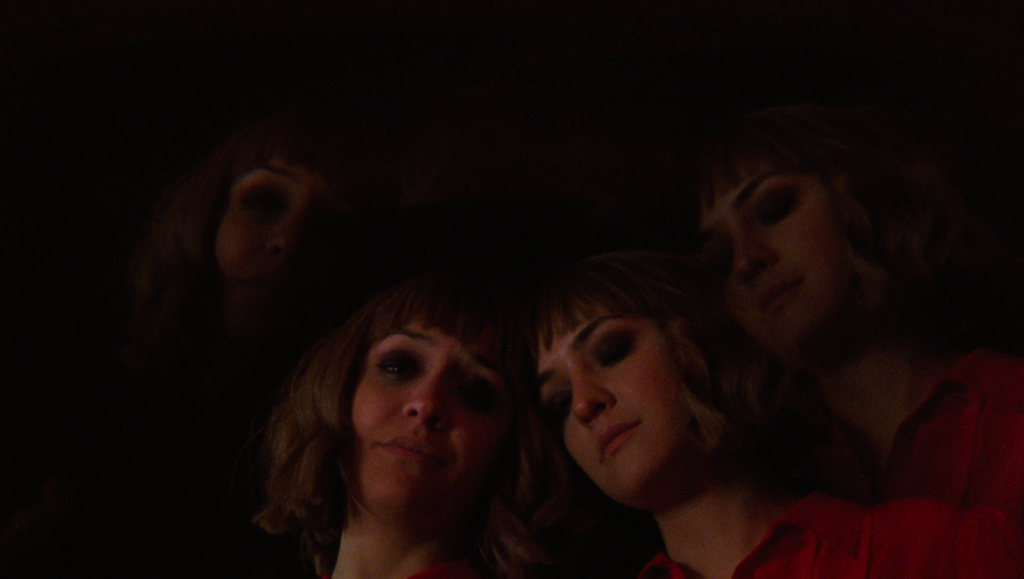Superior sources a number of eerie genre influences in the creation of a bold, singular debut.
Functioning as both an expansion and direct continuation of her 2015 short film of the same title, Erin Vassilopoulos’ Superior is a cryptic, sinister tale of two identical twin sisters whose identities merge and comingle in unexpected ways. Premiering at the 2021 Sundance Film Festival, early reviews pegged the film as, alternately, Lynchian, Almodovar-esque, and even Giallo-by-way-of-De Palma. It’s to Vassilopoulos’ credit, then, that none of these reference points feel especially like a stretch, nor special pleading. Instead, she has managed to wrangle all of these influences into a fairly unique, off-kilter melodrama, aided immeasurably by eye-popping production design and lovely 16mm cinematography.
The film begins with a woman running down a dark road, pursued by a speeding car. It strikes her, and a leather-clad man emerges from the automobile to inspect her body. But she’s still alive, and manages to run to the car, get it started, and run over her attacker. Intercut with this opening sequence are scenes set in the interior of a middle-class suburban home, as a woman prepares eggs in a frying pan and begins unboxing Halloween decorations. One is immediately struck by the presence of colors — a deep red jumpsuit, pink walls, faux wood paneling, crushed velvet pants. Vassilopoulos here lingers on the image of a large seashell, a symbolic object that will take on increased significance as the film progresses. Eventually, it’s revealed that the woman from the car accident is Marian (Alessandra Mesa); she flees the scene of the crime and tracks down her estranged twin sister, Vivian (Ani Mesa, Alessandra’s actual twin). Vivian is married to a boring nobody, Michael (Jake Hoffman), and seems more than willing to bury the hatchet with her long-lost sister, and much of the film charts their tentative steps, as they reacclimate to one another after so many years apart; Marian tells stories about her punk band’s success and upcoming record deal, while Vivian gradually chafes against the strictures of her deadening routine and disinterested husband.
Of course, Vivian doesn’t know that Marian is on the run for committing some kind of crime, and Marian doesn’t know that the man she ran over is actually still alive. Through a series of narrative contrivances, the two decide to impersonate each other; Vivian cuts her hair and takes over Marian’s part-time job at an ice cream stand, while Marian wears Vivian’s outfits and performs domestic duties like cooking and gardening. This section flirts with becoming a hacky sitcom trope, but Vassilopoulos keeps things eerie and vaguely threatening, as Marian has nightmares about her mysterious attacker and Vivian increasingly doubts her feelings for her husband and their attempts to conceive a child.
There’s an emphasis on totemic symbols and genre-based archetypes at play — the blonde femme fatale, the bored housewife, a climactic sequence that references Hitchcock’s Rear Window, domestic melodramas. Thankfully, none of this feels even remotely realistic, nor is there any attempt at traditional indie verisimilitude (it’s fairly remarkable that such a purposefully stylized, even arch production made it through the Sundance wringer; compare it to any number of de rigueur films processed through the screenwriter’s lab). Vassilopoulos and cinematographer Mia Cioffi Henry have constructed a remarkable DIY aesthetic, with clashing color schemes and a variety of surfaces and textures. Vassilopoulos has stated in interviews that the film takes place in 1986, but that is never explicitly stated in the film proper. Indeed, Superior feels like it takes place out of time altogether; there are no cellphones, and while an old CRT television and VCR are featured in several scenes, the outfits and hairstyles exist on a kind of destabilizing retro-futuristic frequency. Vassilopoulos favors simple, largely static camera setups; there are virtually no handheld shots here, little shot-reverse-shot, and no elaborate tracking movements. Instead, there’s a sense of sequences stacking on top of each other, sometimes disjointed but nonetheless accumulating into something larger. It’s always a pleasure to look at, even as the screenplay hems and haws its way to a familiar climax. It’s a remarkably assured debut feature, and despite a few growing pains, heralds a bold new voice.


Comments are closed.